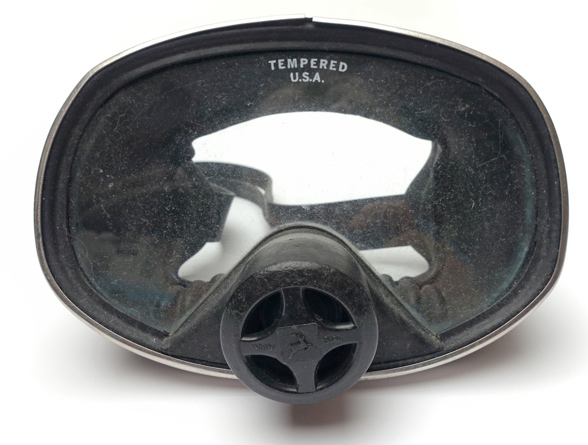The evolution of scuba diving masks from 1950 to 2020 reflects broader advances in materials, diving technology, and user comfort. Here’s a decade-by-decade overview of the major developments:
1950s: The Birth of Recreational Dive Masks
-
Design: Early scuba masks were simple, single-window designs often made from rubber and glass.
-
Fit: Masks had a round or oval shape and covered the eyes and nose. Skirts were thick and less flexible.
-
Straps: Straps were rubber, often with metal buckles that could rust.
-
Limitations: Peripheral vision was poor, and masks could leak or be uncomfortable due to stiff materials.
1960s: Increased Popularity and Refinement
-
Materials: Introduction of tempered glass for safety and better visibility.
-
Design Improvements: Some double-lens masks began appearing, improving fit and comfort.
-
Skirt Material: Rubber still dominated, but refinements in shape improved seals.
1970s: Silicone Enters the Scene
-
Breakthrough: Silicone rubber began to replace traditional rubber for mask skirts.
-
Color: Clear and light-colored skirts became available, making masks less claustrophobic.
-
Better Fit: Manufacturers started offering masks in different sizes and shapes to fit various faces.
1980s: Enhanced Field of View and Comfort
-
Design: Introduction of low-volume masks, reducing the effort to clear water and improving field of view.
-
Peripheral Vision: Side windows were added to some models.
-
Ergonomics: Masks became more contoured to fit faces better, and strap systems improved with quick adjustments.
1990s: Streamlining and Specialization
-
Frameless Masks: Single-lens frameless masks emerged, offering a wider view and better packing for travel.
-
Purge Valves: Some masks began featuring purge valves to allow easier clearing of water.
-
Customization: Prescription lenses became an option.
-
Materials: Continued refinement in silicone quality; hypoallergenic materials became common.
2000s: Innovation and High-Tech Features
-
Lens Coatings: Anti-fog, anti-glare, and UV coatings started to appear.
-
Better Skirts: Dual-feathered skirts increased sealing effectiveness.
-
Design Variety: Divers could choose from a wide range of styles, colors, and shapes.
-
Integration: Some masks were designed to work seamlessly with snorkels or communications systems.
2010s–2020: Enhanced Fit, Vision, and Integration
-
3D Fit Technology: Computer-aided design allowed for masks contoured for optimal facial fit.
-
Wide-View Lenses: Ultra-clear glass and panoramic lenses became standard in high-end masks.
-
Camera Mounts: GoPro-compatible masks became popular.
-
Custom Fit: Moldable silicone and gel skirts started appearing.
-
Eco-Conscious Design: Greater emphasis on sustainable materials and long-lasting components.
Summary of Key Trends:
| Era |
Key Feature |
| 1950s |
Basic rubber masks, single lens |
| 1970s |
Silicone skirts, improved fit |
| 1980s |
Low-volume, wider view |
| 1990s |
Frameless, purge valves, prescription lenses |
| 2000s |
Advanced lens coatings, better seals |
| 2010s–2020 |
Custom fit, camera mounts, panoramic views |

